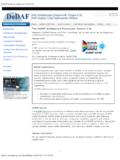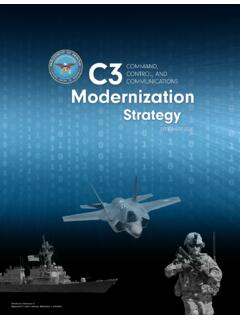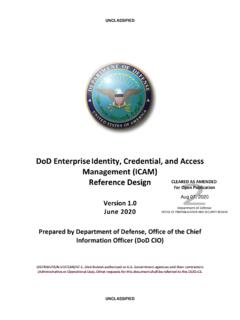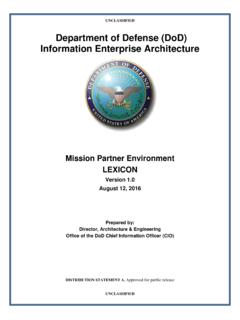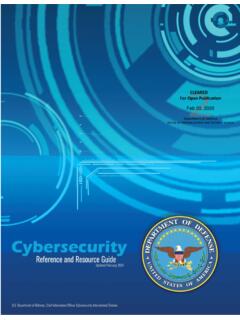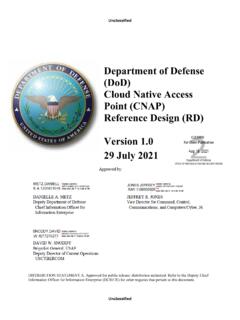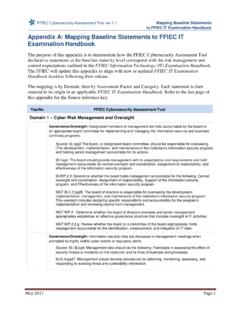Transcription of Department of Defense
1 Department of Defense Identity, Credential, and Access Management (ICAM) Strategy March 30, 2020 DOD ICAM STRATEGY 1 MESSAGE FROM THE DOD CIO The 2018 National Defense Strategy (NDS) acknowledges an increasingly complex global security environment, characterized by overt challenges to the free and open international order and the re-emergence of long-term, strategic competition between nations. Our adversaries are now seeking to exploit vulnerabilities to their advantage. These changes require a clear-eyed appraisal of the threats we face, acknowledgement of the changing character of warfare, and a transformation of how the Department conducts business. Delivering this vision means treating Department of Defense (DoD) information as a strategic asset readily available via robust, rapidly scalable Identity, Credential, and Access Management (ICAM) capabilities that are interoperable across DoD and with domestic and international mission partners.
2 DoD ICAM is defined as: The full range of activities related to the creation of digital identities and maintenance of associated attributes, credential issuance for person/non-person entities, authentication using the credentials, and making access management control decisions based on authenticated identities and associated attributes. This DoD Identity, Credential, and Access Management (ICAM) Strategy is guided by the Department s keystone strategic documents such as the DoD Digital Modernization Strategy and the Cyber Risk Reduction Strategy. The DoD, led by the CIO, is taking a comprehensive approach to cyber Defense . ICAM is integral to this effort by seeking to measure and mitigate the risks identified by the Cyber Risk Reduction Strategy. The vision is a secure trusted environment where people and non-person entities can securely access all authorized resources based on mission need, and where we know who and what is on our networks at any time.
3 This strategy replaces the DoD s Identity and Access Management (IdAM) Strategy, dated October 17, 2014. This strategy applies to all DoD unclassified, secret, top secret, and United States (US) owned releasable networks and information systems under the authority of the Secretary of Defense , including the Special Access Program (SAP) element. Full implementation of this strategy will help secure all parts of the DoD and supports the security of mission partners. The goals and objectives described in this strategy shall be the basis for all DoD ICAM investment, architectures, testing, implementation, operation, governance and policy. An implementation plan with specific and measurable elements will follow that corresponds with the goals and objectives outlined within this strategy. The success of this strategy relies on the collaboration and participation of all DoD military departments, Defense Agencies, and mission partners.
4 Dana Deasy DoD Chief Information Officer DOD ICAM STRATEGY 2 EXECUTIVE SUMMARY Identity, Credential, and Access Management (ICAM) encompasses the full range of activities related to the creation of digital Identities and maintenance of associated attributes, credential issuance for person/non-person entities, authentication, and making access management control decisions based on authenticated identities and associated attributes. This strategy provides a set of goals focused on establishing measurable and achievable transformation of core ICAM elements to achieve ICAM activities. These core elements enable ICAM to be fast, reliable, secure, and auditable across the DoD enterprise in a manner enhancing user experience and supports the DoD Chief Information Officer s (CIO) ICAM vision. DoD Services and Agencies have implemented ICAM principles to protect access to resources they manage.
5 However, decision makers for individual information systems have deployed ICAM capabilities according to their own risk assessments rather than making risk decisions supporting the needs of the DoD enterprise. The lack of deployed capabilities using common standards and enterprise ICAM shared services adds complexity to processes for obtaining access to needed resources, and increases risk to the Department . This bottom up approach for authentication and authorization relies on system owners to make risk-based decisions for managing access to resources, resulting in system owners choosing implementation approaches meeting local needs which may not support enterprise objectives. This strategy provides goals to achieve the ICAM vision of a secure and trusted environment where people and non-person entities can securely access all authorized resources based on mission need, and where we know who is on our networks at any time.
6 This strategy provides a centralized approach to develop, acquire, test, implement, and sustain enterprise ICAM shared services enhancing strategic and tactical missions, and requires adoption of their use in DoD systems. The Department must also integrate widely recognized and adopted commercial standards, architectures and related, compliant products to minimize modernization costs and facilitate interoperability. This approach balances the DoD requirement to share and protect information at an enterprise level and system owner needs to make supporting risk-based decisions. Finally, DoD must collaborate with its mission partners in other Federal Departments and Agencies, the Defense Industrial Base, and allied and coalition foreign governments to maximize interoperability with their ICAM technologies. The seven goals of this strategy and their accompanying objectives are designed to focus Department resources towards building and deploying solutions enabling automated provisioning and dynamic access.
7 These capabilities will help share information across the Department , and with our mission partners, while managing risks and protecting information against unauthorized access. Goal 1: Implement a data centric approach to collect, verify, maintain, and share identity andother attributes. Goal 2: Improve and enable authentication to DoD networks and resources through commonstandards, shared services, and federation. Goal 3: Deploy shared services promoting the implementation of enterprise ICAM. Goal 4: Enable consistent monitoring and logging to support identity analytics for detectinginsider threats and external attacks. Goal 5: Enhance the governance structure promoting the development and adoption ofenterprise ICAM solutions. Goal 6: Create DoD policies and standards clearly defining requirements for identification,credentialing, authentication, and authorization lifecycle management.
8 Goal 7: Sustain the execution and evolution of ICAM activities to support the needs of DoDcomponents to carry out their mission objectives and the needs of the DoD enterprise to secureDoD resources. 3 TABLE OF CONTENTS 1. INTRODUCTION .. 1 VISION .. 1 SCOPE .. 1 BACKGROUND .. 2 CURRENT STATE OF ICAM ACROSS THE DOD 2 A CHANGE IN DIRECTION .. 5 2. STRATEGIC GOALS AND OBJECTIVES .. 6 1. IMPLEMENT A DATA CENTRIC APPROACH TO COLLECT, VERIFY, MAINTAIN, AND SHARE IDENTITY AND OTHER ATTRIBUTES .. 6 2. IMPROVE AND ENABLE AUTHENTICATION TO DOD NETWORKS AND RESOURCES THROUGH COMMON STANDARDS, SHARED SERVICES, AND FEDERATION .. 7 3. DEPLOY SHARED SERVICES PROMOTING THE IMPLEMENTATION OF ENTERPRISE ICAM .. 8 4. ENABLE CONSISTENT MONITORING AND LOGGING TO SUPPORT IDENTITY ANALYTICS FOR DETECTING INSIDER THREATS AND EXTERNAL ATTACKS .. 9 5.
9 ENHANCE THE GOVERNANCE STRUCTURE PROMOTING THE DEVELOPMENT AND ADOPTION OF ENTERPRISE ICAM SOLUTIONS ..10 6. CREATE DOD POLICIES AND STANDARDS CLEARLY DEFINING REQUIREMENTS FOR IDENTIFICATION, CREDENTIALING, AUTHENTICATION, AND AUTHORIZATION LIFECYCLE MANAGEMENT ..11 7. SUSTAIN THE EXECUTION AND EVOLUTION OF ICAM ACTIVITIES TO SUPPORT THE NEED OF DOD COMPONENTS TO CARRY OUT THEIR MISSION OBJECTIVES AND THE NEEDS OF THE DOD ENTERPRISE TO SECURE DOD RESOURCES ..12 1 1. INTRODUCTION This strategy is a significant revision of the 2014, DoD Identity and Access Management Strategy. It provides greater emphasis on credentialing, governance, policy, and shared services and aligns with the 2018 National Defense Strategy and the 2019 Digital Modernization Strategy. Consistently deployed effective ICAM solutions are critical to achieving the three lines of effort outlined in the 2018 National Defense Strategy, [f]irst, rebuilding military readiness as we build a more lethal Joint Force; [s]econd, strengthening alliances as we attract new partners; and [t]hird, reforming the Department s business practices for greater performance and affordability.
10 ICAM implementation also provides a baseline capability to achieve other Department objectives such as Zero Trust. This strategy provides historical reasoning why changes are needed and identifies seven goals closing the gap between what must be and today s splintered ICAM environment that creates risk for the Department . VISION A secure trusted environment where people and non-person entities can securely access all authorized resources based on mission need, and where we know who and what is on our networks at any time. SCOPE This ICAM Strategy encompasses the full range of activities related to the creation of digital identities and maintenance of associated attributes, credential issuance for person/non-person entities, authentication using the credentials, and making access management control decisions based on authenticated identities and associated attributes.
